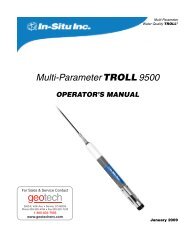TEST INSTRUCTIONS - Geotech Environmental Equipment
TEST INSTRUCTIONS - Geotech Environmental Equipment
TEST INSTRUCTIONS - Geotech Environmental Equipment
You also want an ePaper? Increase the reach of your titles
YUMPU automatically turns print PDFs into web optimized ePapers that Google loves.
ZINC–LOW RANGE<br />
ZINCON METHOD CODE 3667-SC<br />
QUANTITY CONTENTS CODE<br />
30 mL *Zinc Indicator Solution *6314-G<br />
120 mL *Methyl Alcohol *6319-J<br />
10 g Sodium Ascorbate Powder 6316-D<br />
25 g *Zinc Buffer Powder *6315-G<br />
15 mL *Sodium Cyanide, 10% *6565-E<br />
30 mL *Formaldehyde Solution, 37% *5128-G<br />
1 “Dilute Zinc Indicator Solution” Bottle,<br />
w/1 pipet assembly<br />
0128-MT<br />
1 Graduated Cylinder, 10 mL, glass 0416<br />
1 Spoon, 0.5 g, plastic 0698<br />
2 Pipets, plain, plastic 0352<br />
1 Spoon, 0.1 g, plastic 0699<br />
*WARNING: Reagents marked with an * are considered hazardous substances. To<br />
view or print a Material Safety Data Sheet (MSDS) for these reagents see MSDS CD<br />
or our web site. To obtain a printed copy, contact us by e-mail, phone or fax.<br />
Zinc enters the domestic water supply from the deterioration of galvanized iron<br />
and brass pipes, and from industrial wastes. Zinc is an essential element for<br />
body growth and development and is an important plant nutrient.<br />
Concentrations of zinc above 5.0 mg/L in drinking water can cause a bitter<br />
astringent taste. In the U.S., zinc concentrations may vary between 0.06 to 7.0<br />
mg/L,withanaveragevalueof1.33mg/L.<br />
APPLICATION: Drinking and surface waters, domestic and industrial waste<br />
water.<br />
RANGE: 0.00–3.00 ppm Zinc<br />
METHOD: Zinc forms a blue colored complex with Zincon in a solution<br />
buffered at pH 9.0. Other heavy metals are complexed by<br />
cyanide and the zinc cyanide complex is released by the<br />
addition of formaldehyde before the other metal cyanide<br />
complexes are destroyed. Sodium ascorbate is added to<br />
SAMPLE<br />
HANDLING &<br />
PRESERVATION:<br />
reduce the interference of manganese.<br />
Sample should be analyzed within 6 hours after collection.<br />
The addition of hydrochloric acid will help preserve the<br />
metal ion content, however the acid should be neutralized<br />
before analysis.<br />
Smart2 <strong>TEST</strong> PROCEDURES 2.04 Zinc–LR 1/3

















